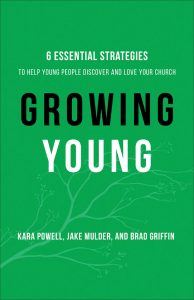One core commitment that can help a congregation engage younger people is a willingness to entrust teens and emerging adults with the “keys” to real influence and agency by giving away access, power, and responsibility. The authors of Growing Young call this empowering style of leadership “keychain leadership.”
Is leadership style a critical variable in helping a church reach younger people? In Growing Young (Baker Books, 2016), researchers Kara Powell, Jake Mulder, and Brad Griffin identify several core commitments for congregations seeking to engage young people. They include:
- empathizing with young people rather than judging them
- focusing on a Jesus-centered way of life rather than formulaic faith claims
- fostering genuine community and intergenerational relationships
- demonstrating support of younger people in tangible ways with resources and actions
- enabling connections with local and global neighbors
Keychain leadership is not a matter of simply abdicating control or handing off a job. It is an active leadership posture that empowers others through close collaboration, relational connections, and hard work.
While any of these commitments can be a starting point, one additional commitment was found to be most likely to ignite a process of growing young — a commitment to a style of leadership they call keychain leadership. “Keychain leaders,” they write, “are very aware of the keys they hold; they are constantly opening doors for some while training and entrusting others who are ready for their own set of keys.” Keychain leaders model a posture of giving away access and authority. They are intentional about entrusting all generations, including teenagers and emerging adults, with power, responsibility, and access to other leaders.
Keychain leadership is not a matter of simply abdicating control or handing off a job to someone else. It is an active rather than a passive leadership posture that empowers others through close collaboration, relational connections, and hard work. Its goal is moving young people from participants to contributing partners in ministry.
Fortunately, this type of leadership can be embodied by people of any age and in any aspect of church life. There is value, according to the authors of Growing Young, in having young leaders who can connect with other young people. But their research suggests most of the leaders impacting the development of younger adults in the church are mature. At the end of the day, being authentic, transparent, and warm matters more in connecting with younger people than being hip or trendy.
It’s also not the case that you need pastors or staff focused exclusively on youth or young adult ministry. Keychain leaders tend to have multifaceted involvements in various aspects of church life. And this helps break down the age-related silos that prevent younger people from penetrating the life of the church.
How can you become a keychain leader? Start by assessing your major responsibilities. What keys are on your own keychain? And how might they be shared or given away? It’s also important simply to make time to be with young people — whether it’s inviting people into your home or deliberately hanging out after worship services.
Jesus gave the keys to his kingdom to his disciples. Isn’t it time we learned to share our keys with younger people?
 This article draws from Growing Young: Six Essential Strategies to Help Young People Discover and Love Your Church. (Baker Books, 2016) by Kara Powell, Jake Mulder, and Brad Griffin.
This article draws from Growing Young: Six Essential Strategies to Help Young People Discover and Love Your Church. (Baker Books, 2016) by Kara Powell, Jake Mulder, and Brad Griffin.
Related Resources
- 10 Qualities Your Church Doesn’t Need to Grow Young by Brad Griffin, Jake Mulder, and Kara Powell
- What Churches do Young Adults Attend by Lovett H. Weems, Jr.
- Leading Ideas to Reach Young Adults, a Lewis Center eBook







